 W
WThe Adoration of the Kings is a large oil-on-oak painting by Jan Gossaert, dated to 1510–15, depicting the Adoration of the Magi. Although Gossaert's name is signed on the border of Balthazar's richly embroidered headdress, and on a collar worn by Balthazar's turbaned attendant, the painting was occasionally attributed to Albrecht Dürer in the 17th and 18th centuries. In 2010, Ainsworth suggested that the work was a collaboration between Gossaert and Gerard David.
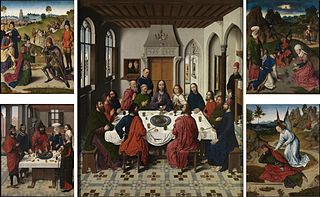 W
WAltarpiece of the Holy Sacrament or Triptych of the Last Supper is a 1464–1468 dated triptych attributed to Dieric Bouts, now reassembled and held at its location of origin at St. Peter's Church, Leuven.
 W
WBacchus, formerly Saint John the Baptist, is a painting in the Musée du Louvre, Paris, France, based on a drawing by the Italian Renaissance artist Leonardo da Vinci. It is presumed to have been executed by an unknown follower, perhaps in Leonardo's workshop. Sydney J. Freedberg assigns the drawing to Leonardo's second Milan period. Among the Lombard painters who have been suggested as possible authors are Cesare da Sesto, Marco d'Oggiono, Francesco Melzi, and Cesare Bernazzano. The painting shows a male figure with garlanded head and leopard skin, seated in an idyllic landscape. He points with his right hand off to his left, and with his left hand grasps his thyrsus and also points down to earth.
 W
WThe Bellanti Madonna is a c.1515 oil on canvas painting. Long attributed to Girolamo del Pacchia, Vigni reattributed it as a youthful work by Domenico Beccafumi in 1936, an attribution accepted by most other later art historians. Heavily influenced by Michelangelo, its oval format is also influenced by Raphael's Madonnas, as are other Beccafumi works of the period such as the Madonna and Child in his Saint Paul Enthroned. Previously in the Bellanti collection, it is now one of several works by Beccafumi in the Pinacoteca Nazionale in Siena, including another Madonna and Child from 1514.
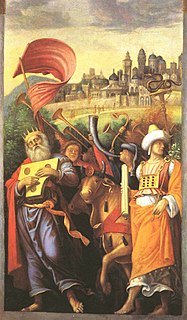 W
WDavid Before the Ark of the Covenant is a c.1515 oil on canvas painting of King David by Correggio, rediscovered as a work by that artist by Giovanni Romano in 1996, an attribution accepted soon afterwards by David Ekserdjian. It is now in a private collection in Turin.
 W
WDrunkenness of Noah is a painting by the Italian artist Giovanni Bellini. It was finished about 1515. It is kept in the Museum of Fine Arts and Archeology of Besançon, France.
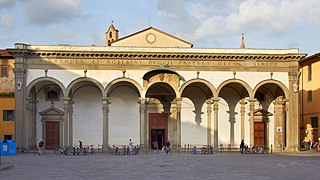 W
WThe Basilica della Santissima Annunziata is a Renaissance-style, Roman Catholic minor basilica in Florence, region of Tuscany, Italy. This is considered the mother church of the Servite Order. It is located at the northeastern side of the Piazza Santissima Annunziata near the city center.
 W
WFlora is an oil painting by Italian late Renaissance painter Titian, dated to around 1515 and now held at the Uffizi Gallery in Florence.
 W
WThe Holy Family with Saint Jerome is a 68 by 56 cm oil on poplar panel painting by Correggio. It dates to around 1515 and is now displayed in the East Closet of Hampton Court Palace as part of the Royal Collection. It has similarities with the Holy Family with the Infant Saint John the Baptist and so it probably dates to around the time Correggio painted the frescoes in the Camera di San Paolo or possibly slightly earlier. It shows the Holy Family and saint Jerome.
 W
WHoly Family with the Infant Saint John the Baptist is a c.1514–1515 oil on canvas painting by Domenico Beccafumi, now in the Uffizi in Florence.
 W
WThe Isenheim Altarpiece is an altarpiece sculpted and painted by, respectively, the Germans Nikolaus of Haguenau and Matthias Grünewald in 1512–1516. It is on display at the Unterlinden Museum at Colmar, Alsace, in France. It is Grünewald's largest work, and is regarded as his masterpiece. It was painted for the Monastery of St. Anthony in Isenheim near Colmar, which specialized in hospital work. The Antonine monks of the monastery were noted for their care of plague sufferers as well as their treatment of skin diseases, such as ergotism. The image of the crucified Christ is pitted with plague-type sores, showing patients that Jesus understood and shared their afflictions. The veracity of the work's depictions of medical conditions was unusual in the history of European art.
 W
WJoseph Sold to Potiphar is a c.1515 oil on panel painting by Pontormo, now in the National Gallery in London. Like The Baker Tortured, Joseph in Egypt and Joseph's Brothers Ask Him For Help, it was originally painted for the Marriage Chamber of the Palazzo Borgherini.
 W
WThe Lamentation of Christ is a painting of the common subject of the Lamentation of Christ by the painter and manuscript illuminator Gerard David, originally a wing of a now dismantled and lost altarpiece.
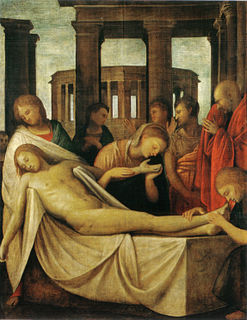 W
WLamentation over the Dead Christ is an oil painting on canvas of c. 1515–1520 by Bramantino, painted for the church of San Barnaba in Milan. The work was acquired by the Werner family in 1985 and now in the Pinacoteca del Castello Sforzesco in the same city. A copy is now in a private collection.
 W
WLeda and the Swan is a c.1515 painting by Cesare da Sesto, a painter in the circle of Leonardo da Vinci. It is now in Wilton House near Salisbury, UK. With other versions now at the Galleria Borghese and Uffizi, it is thought to be one of three of the closest copies after Leonardo's own lost work on the subject.
 W
WLucretia and her Husband Lucius Tarquinius Collatinus or Tarquin and Lucretia is an oil painting attributed to Titian, dated to around 1515 and now in the Kunsthistorisches Museum in Vienna. The attribution to this artist is traditional but uncertain - the brightened palette suggests it could instead be by Palma Vecchio. However, others identify the painting as part of Titian's series of half-length female figures from 1514 to 1515, which also includes the Flora at the Uffizi, the Woman with a Mirror at the Louvre, the Violante and the Young woman in a black dress in Vienna, Vanity in Munich and the Salome at the Galleria Doria Pamphilj. There is an early copy in the Royal Collection.
 W
WThe Lute Player is a 1514-1516 oil on canvas painting by Giovanni Cariani, now in the Musée des Beaux-Arts in Strasbourg, France. Its inventory number is 236.
 W
WMadonna and Child with Saints is a 1515 oil on panel painting by Cima da Conegliano, now in the Cleveland Museum of Art, Ohio.
 W
WMadonna and Child with St Francis or Madonna of St Francis is a 1514-1515 painting by Correggio, now held in the Gemäldegalerie Alte Meister in Dresden, Germany. It shows Francis of Assisi, with the stigmata, prostrating himself before an enthroned Madonna and Child - the work's theme is the intercession of the Madonna, which was promoted by the Franciscans after the definition of the dogma of the Immaculate Conception in 1473. Francis is supported by Anthony of Padua, whilst on the right are Catherine of Alexandria and John the Baptist and on the base of the Madonna's throne is a small grisaille image of Moses with the tablets of the law. Catherine's wheel bears the painter's signature "Antonivs de Alegri F.[ecit]".
 W
WMadonna and Child with St Herculanus and St Constantius or Madonna of the Kitchen is a 1515 painting by Perugino, now in the Galleria Nazionale dell'Umbria in Perugia. Its title refers to the fact that it once hung in the former kitchen of the Palazzo dei Priori in Perugia. The two accompanying saints are Herculanus and Constantius, both local saints to Perugia.
 W
WThe Madonna of the Cherries is a 1515 painting by Titian, heavily influenced by the work of Giovanni Bellini. Originally oil on wood, it was later transferred to canvas. During the 17th century it formed part of the collection of Archduke Leopold Wilhelm, where it was copied by David Teniers. It is now in the Kunsthistorisches Museum in Vienna.
 W
WThe Myth of Prometheus is a series of two panels painted by Piero di Cosimo, executed in 1515. It shows Prometheus standing before a life-size statue.
 W
WNaked Young Woman in Front of a Mirror is an oil on poplar panel painting by Giovanni Bellini. Dating to 1515, it was one of his last works, showing him responding to the tonalism introduced by Giorgione. It was acquired by James Hamilton, 1st Duke of Hamilton in 1638 and remained with his family until 1659, when it was acquired in Brussels by Leopold William of Austria. It is now in the Kunsthistorisches Museum in Vienna.
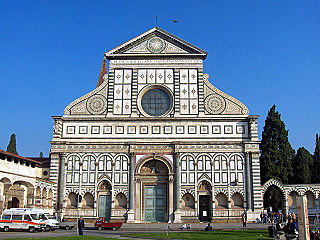 W
WSanta Maria Novella is a church in Florence, Italy, situated opposite, and lending its name to, the city's main railway station. Chronologically, it is the first great basilica in Florence, and is the city's principal Dominican church.
 W
WPharaoh with his Butler and Baker is a c.1515 oil on panel painting by Pontormo, now in the National Gallery, London. Like Joseph Sold to Potiphar, Joseph in Egypt and Joseph's Brothers Ask Him For Help, it was originally painted for the Marriage Chamber at the Palazzo Borgherini in Florence.
 W
WPortrait of a Knight of Malta is a c.1515 oil on canvas painting by Titian of a knight belonging to the Order of Malta. It is now in the Uffizi in Florence. The last bead of the rosary held by the knight bears the number XXXV (35), showing the subject's age at the time of the portrait. W.F. Dickes. argued that he was Stefano Colonna, the condottiero who led the republican resistance during the siege of Florence. cited in
 W
WPortrait of a Man is a c.1515 male oil on canvas portrait by Titian, now in the Indianapolis Museum of Art.
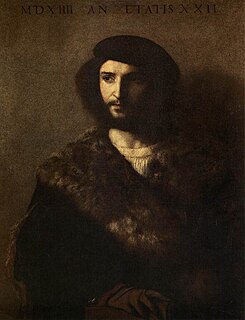 W
WPortrait of a Sick Man is a 1515 oil on canvas painting by Titian. It is now in the Uffizi in Florence. The work is inscribed "MDXIIIII AN. ETATIS XXII". Its title derives solely from the unknown subject's pallid face and melancholy expression. One hypothesis holds him to be Claudio Tolomei, but this is not widely accepted.
 W
WThe Portrait of Bindo Altoviti is a painting finished around 1515 by the Italian High Renaissance painter Raphael. It is housed in the National Gallery of Art of Washington, D.C., United States.
 W
WPortrait of Giovanni Agostino della Torre and his son Niccolò is a 1515 oil on canvas painting by Lorenzo Lotto and now in the National Gallery, London. It is signed and dated "L.[aurentius] Lotus P.[inxit] / 1515". Its subjects have been identified via inscriptions scattered throughout the painting. They both practised medicine and pharmacy in Bergamo, selling iron vitriol from a shop on Piazza Vecchia - it was probably the first portrait Lotto produced in that city.
 W
WPortrait of Giovanni della Volta with his Wife and Children is a 1515 portrait by Lorenzo Lotto, now in the National Gallery, London, to which it was left by Miss Sarah Solly in 1879.
 W
WThe Rest on the Flight into Egypt is an oil painting of around 1515 by the Flemish painter Gerard David now in the Metropolitan Museum of Art.
 W
WThe Rest on the Flight into Egypt is an oil painting of around 1515 by the Flemish painter Gerard David now in the Royal Museum of Fine Arts Antwerp. It can be compared with other works on the same theme by the same painter in Madrid, Washington and New York and a Virgin and Child in Rotterdam.
 W
WSaint Catherine of Siena Receiving the Stigmata is a c.1515 oil on canvas painting by Domenico Beccafumi, now in the Pinacoteca Nazionale di Siena.
 W
WSaint Jerome in Penitence is a 1515 oil on canvas painting by Italian Renaissance artist Lorenzo Lotto, now in the Allentown Art Museum in Pennsylvania, USA. It is signed on the rock next to the saint.
 W
WSaint Paul Enthroned is an oil on canvas painting by Domenico Beccafumi, now in the Museo dell'Opera del Duomo in Siena. It is dated to c.1515 due to its style, before his St Catherine of Siena Receiving the Stigmata and after his trip to Rome, where he had come into contact with Sodoma and Florentine artists of the period - the figure of the saint draws on the prophets in Michelangelo's Sistine Chapel ceiling whilst those in the background draw on Dürer and Piero di Cosimo.
 W
WSalome is an oil painting, probably of Salome with the head of John the Baptist, by the Italian late Renaissance painter Titian. It is usually dated to around 1515 and is now in the Doria Pamphilj Gallery in Rome. Like other paintings of this subject, it has sometimes been considered to represent Judith with the Head of Holofernes, the other biblical incident found in art showing a female and a severed male head. Historically, the main figure has also been called Herodias, the mother of Salome.
 W
WThe St Catherine Altarpiece is a set of panel paintings from the period around 1515 that is ascribed to the workshop of the Master of the Litoměřice Altarpiece. A total of six panel paintings survive from the original retable: one wing painted on both sides and two panels painted on one side in the collection of the National Gallery in Prague and two panels in the private collection of G. Schäfer (Schweinfurt).
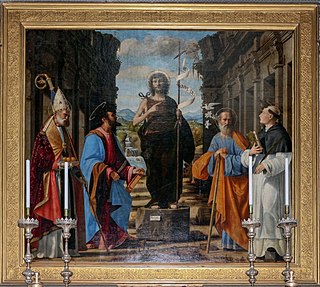 W
WSt John the Baptist with Four Saints or St John the Baptist Among Other Saints is a 1515 oil on canvas painting by Andrea Previtali, displayed in the first side-chapel on the north side of the nave of the church of Santo Spirito in Bergamo, the artist's birthplace. It was the artist's first public commission after his return to Bergamo from Venice.
 W
WSt Lanfranc enthroned between St John the Baptist and St Liberius is an oil painting by Cima da Conegliano dating to 1515-16. It is now in the Fitzwilliam Museum, Cambridge. It shows saint Lanfranc on a throne, between John the Baptist and Saint Liberius.
 W
WThe Baptism of Christ is an oil on oak painting executed c.1515 by the Flemish Renaissance painter Joachim Patinir which is now in the collection of the Kunsthistoriches Museum in Vienna.
 W
WVanity is an oil painting by the Italian late Renaissance painter Titian, dated to around 1515 and now held at the Alte Pinakothek in Munich, Germany.
 W
WLa velata, or La donna velata, is a well known portrait by the Italian Renaissance painter Raphael. The subject of the painting appears in another portrait, La Fornarina, and is traditionally identified as the fornarina (bakeress) Margherita Luti, Raphael's Roman mistress.
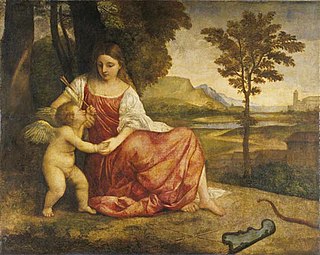 W
WVenus and Cupid is a 1510-1515 oil on canvas painting by Titian, now in the Wallace Collection in London. It is dated by the model for Venus, who also appeared in other 1510s works by the artist such as his Salome.
 W
WViolante is an oil painting attributed to Titian, dated to around 1515 and now held at the Kunsthistorisches Museum in Vienna.
 W
WVirgin and Child with Four Angels is a small oil-on-panel painting by the Early Netherlandish artist Gerard David. Likely completed between 1510 and 1515, it shows the Virgin Mary holding the child Jesus, while she is crowned Queen of Heaven by two angels above her, accompanied by music provided by another two angels placed at either side of her. In its fine detail and lush use of colour the work is typical of both David and late period Flemish art.
 W
WVirgin in Glory with Saints is a 1510-1515 oil on panel painting by Giovanni Bellini and probably also his studio, now in the Gallerie dell'Accademia in Venice. It measures 3.5 m by 2.25 m and shows the Assumption of Mary, which is usually shown witnessed by the apostles - here it is instead seen by saint Mark, John the Evangelist, saint Luke, Francis of Assisi with the stigmata, Louis of Toulouse as a young bishop, Anthony the Great, Augustine of Hippo and John the Baptist.
 W
WWoman with a Basket of Spindles is a c.1514-1515 oil on panel painting now in the Uffizi in Florence. It is attributed to Pontormo or Andrea del Sarto. The work arrived in the Palazzo Pitti's gallery in 1773, as recorded in a note on the reverse, and in 1784 is was hanging in the Sala dell'Ermafrodito. It was last restored in 1996.
 W
WWoman with a Mirror is a painting by Titian, dated to c. 1515 and now in the Musée du Louvre.